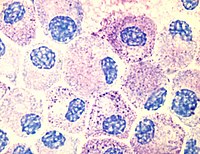
Photo from wikipedia
Peptide based therapeutics are desirable owing to their high biological specificity. However, a number of these fail in clinical testing due to an adverse inflammatory response. Mast cells play a… Click to show full abstract
Peptide based therapeutics are desirable owing to their high biological specificity. However, a number of these fail in clinical testing due to an adverse inflammatory response. Mast cells play a key role in directing the host response to drugs and related products. Although the role of FcεRI receptor is well known, Mas-related G-protein coupled receptor X2 (MRGPRX2) binding of endogenous peptides, and drugs will activate mast cells independent of FcεRI. Identifying peptides that activate mast cells through MRGPRX2, and their respective activation potency, can be used to reduce the failure rate of peptide therapeutics at clinical trial. Moreover, it will allow for peptide design where mast cell activation is actually desired. It was found that FRKKW and WNKWAL are two motifs that activate human LAD2 cells similar to PAMP-12 controls. Peptide activators of MRGPRX2 could be reduced to Xa-(Y)(n ≥ 3)-Xb where: Xa is an aromatic residue; Xb is a hydrophobic residue; and Y is a minimum 3 residue long sequence, containing a minimum of one positively charged residue with the remainder being uncharged residues. Artificial peptides WKKKW and FKKKF were constructed to test this structural functionality and were similar to PAMP-12 controls. Peptides with different activation potentials were found where FRKKW = WKKKW = FKKKF > PAMP-12 = WNKWAL > YKKKY > FRKKANKWALSR = FRKKWNKAALSR > KWKWK > FRKK = WNKWA > KYKYK > NKWALSR = YKKY = WNK. These sequences should be considered when designing peptide-based therapeutics. STATEMENT OF SIGNIFICANCE: Mast cells release immune regulating molecules upon activation that direct host's immune response. MRGPRX2 receptor provides an alternate pathway for mast cell activation that is independent of FcεRI receptor. It is thought that mast cell activation through MRGPRX2 plays a critical role in high failure rates of drugs in clinical trials. Identifying peptide sequences that activate mast cells through MRGPRX2 can serve two important purposes, namely, sequences to avoid when designing peptide therapeutics, and artificial peptides with different activation potentials for mast cells. Herein, we have identified a general amino acid sequence that induces mast cell activation through MRGPRX2. Furthermore, by modulating the identified sequence, artificial peptides have been designed which activate mast cells by varying degrees for therapeutic applications.
Journal Title: Acta biomaterialia
Year Published: 2021
Link to full text (if available)
Share on Social Media: Sign Up to like & get
recommendations!